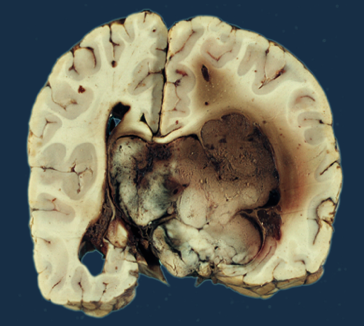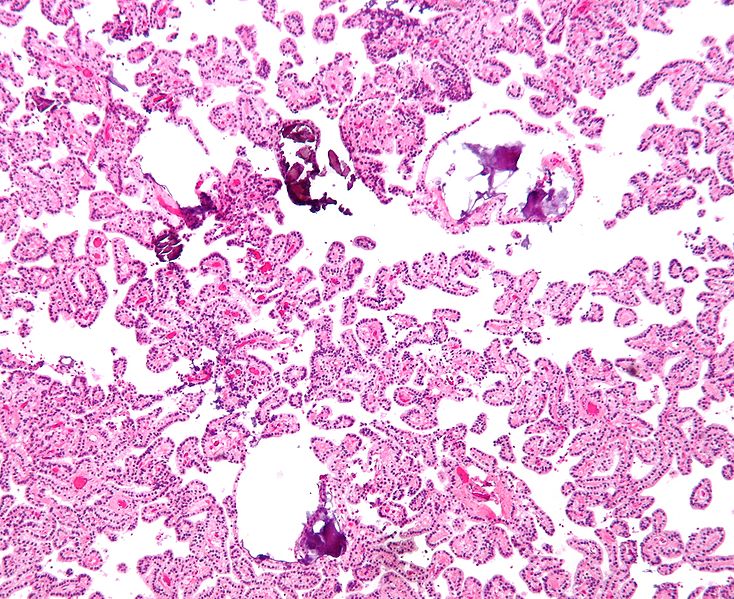Choroid plexus papilloma
For patient information, click here
Template:Choroid plexus papilloma Editor-In-Chief: C. Michael Gibson, M.S., M.D. [1]Associate Editor(s)-in-Chief: Sujit Routray, M.D. [2]
Synonyms and keywords: Choroid plexus papillomas; Papilloma of choroid plexus; Papilloma of the choroid plexus; CPP
Overview
Choroid plexus papilloma was first described by Guerard, in 1832.[1]Choroid plexus papilloma may be classified into two groups: typical and atypical.[2]
Historical Perspective
Choroid plexus papilloma was first described by Guerard, in 1832.[1]
Classification
Choroid plexus papilloma may be classified into two groups:[2]
Choroid plexus papilloma | |||||||||||||||||||||||||||||||||||||||||||||||||||||||||||||||||||||||
Typical | Atypical | ||||||||||||||||||||||||||||||||||||||||||||||||||||||||||||||||||||||
WHO grade I | WHO grade II | ||||||||||||||||||||||||||||||||||||||||||||||||||||||||||||||||||||||
Pathophysiology
- Choroid plexus papilloma is neuroectodermal in origin and similar in structure to a normal choroid plexus. They may be created by epithelial cells of the choroid plexus.[3]
- It may be a true congenital intracranial neoplasm.
Choroid plexus papilloma may be associated with:[4][5]
- Aicardi syndrome
- Von Hippel-Lindau disease
- Li-Fraumeni syndrome
- On gross pathology, choroid plexus papilloma is characterized by a soft, solid, pink to red, capsulated, vascular, and friable cauliflower-like mass.[4]
- Unlike most other brain tumors which are more common in the posterior fossa in children and supratentorial compartment in adults, the relationship is reversed for choroid plexus papillomas:
- Adults: 70% occur in the fourth ventricle
- Children: most often occur in the lateral ventricles, with a predilection for the trigone
- Third ventricular, cerebellopontine angle, parenchymal and even pineal region tumors have also been described.
Gallery
-
Gross pathological specimen of choroid plexus papilloma.
Microscopic Pathology
- On microscopic histopathological analysis, choroid plexus papilloma is characterized by papillary structures with a delicate fibrovascular core lined by columnar or cuboidal epithelial cells with vesicular nuclei. Its appearance is very similar to normal choroid plexus.[4]
- If two or more mitoses are present per 10 high power field (HPF), then the tumor is designated an atypical choroid plexus papilloma and is classified as a WHO grade II tumor.
Gallery
-
Shown above is a micrograph of choroid plexus papilloma (H&E stain).
Causes
- There are no established causes for choroid plexus papilloma.[6]
Differentiating Choroid Plexus Papilloma from other Diseases
Choroid plexus papilloma may be differentiated from:[7][1]
- Choroid plexus carcinoma
- Choroid plexus metastasis
Among children, choroid plexus papilloma must be differentiated from:[7]
- Medulloblastoma
- Atypical teratoid rhabdoid tumor (AT/RT)
- Papillary anaplastic ependymoma
- Pineocytoma
- Pineoblastoma
Among adults, choroid plexus papilloma must be differentiated from:[7]
Epidemiology and Demographics
Prevalence
- Choroid plexus papilloma accounts for approximately 1% of all brain tumors, 2-6% of all pediatric brain tumors, and 0.5% of the adult brain tumors.[8]
- They are far more common than the more aggressive choroid plexus carcinoma (WHO grade III), which they outnumber 5:1.[9]
Age
- Choroid plexus papilloma is a rare disease that tends to affect children and adults.[8]
- Approximately 85% of all choroid plexus papilloma occurs in children under the age of 5 years.
Gender
- Males are more commonly affected with choroid plexus papilloma than females. The male to female ratio is approximately 2.8 to 1.[10]
Risk Factors
- There are no established risk factors for choroid plexus papilloma.
Screening
- There is insufficient evidence to recommend routine screening for choroid plexus papilloma.[11]
Natural History, Complications and Prognosis
- If left untreated, patients with choroid plexus papilloma may progress to develop seizures, hydrocephalus, focal neurological deficits, cranioneuropathies, psychosis, and coma.[1][6]
- Common complications of choroid plexus papilloma include CSF seeding, obstructive hydrocephalus, blindness, psychosis, and coma. The prognosis is excellent, and the 5-year survival rate after complete excision of choroid plexus papilloma is approximately 100%.[6][12]
Diagnosis
Symptoms
When evaluating a patient for choroid plexus papilloma, you should take a detailed history of the presenting symptom (onset, duration, and progression), other associated symptoms, and a thorough family and past medical history review. Other specific areas of focus when obtaining the history include the review of common associated conditions such as Aicardi syndrome, Von Hippel-Lindau disease, and Li-Fraumeni syndrome.[4][5] Symptoms of choroid plexus papilloma include headache, vomiting, seizures, and vision loss.[13][1]
Physical Examination
Common physical examination findings of choroid plexus papilloma include:[13][1][6]
HEENT
- Bulging fontanelle
- Enlarged head size
- Papilledema
- Homonymous hemianopia
- Mild upward gaze paresis
- Facial asymmetry
Neurological
- Altered mental status
- Gait ataxia
- Focal neurological deficits
- Cerebellar signs
- Cranioneuropathies
- 6th and 7th nerve palsy
Laboratory Findings
- There are no specific laboratory findings associated with choroid plexus papilloma.
- Other laboratory findings consistent with the diagnosis of choroid plexus papilloma is immunohistochemistry.
Immunohistochemistry
- Choroid plexus papilloma is demonstrated by positivity to tumor marker such as cytokeratin (CK7).[4]
- Some reactivity for GFAP and epithelial membrane antigen may be present.[1]
Imaging Findings
CT
- Head CT scan is helpful in the diagnosis of choroid plexus papilloma.
- On CT scan, choroid plexus papilloma is characterized by:[14][1]
- Well-defined lobulated masses
- Iso- or somewhat hyperdense compared to the adjacent brain
- Associated hydrocephalus
- Fine, speckled calcification (25%)
- Microhemorrhage
- Intense homogenous enhancement, with an irregular frond-like pattern
- If there is markedly heterogeneous contrast enhancement, a choroid plexus carcinoma should be suspected
Gallery
-
The mass is relatively well circumscribed, slightly hyperdense compared to grey matter on CT, and following administration of contrast demonstrates vivid enhancement.[15]
MRI
- Brain MRI is helpful in the diagnosis of choroid plexus papilloma.
- On MRI, choroid plexus papilloma is characterized by:[14]
| MRI component | Findings |
|---|---|
|
T1 |
|
|
T2 |
|
|
T1 with contrast |
|
Gallery
-
Brain MRI T1 with contrast image demonstrates a vividly but heterogeneously enhancing mass in the right side of the 4th ventricle is associated with significant surrounding edema and mass effect. There is ventricular enlargement consistent with non-communicating hydrocephalus.[16]
-
Axial T2-weighted MRI image demonstrates a 17 x 16 x 17 mm hyperintense mass within the floor of the fourth ventricle. No extension into the foramen of Luschka is observed.[17]
Other Diagnostic Studies
- [Disease name] may also be diagnosed using [diagnostic study name].
- Findings on [diagnostic study name] include [finding 1], [finding 2], and [finding 3].
Treatment
Medical Therapy
- There is no treatment for [disease name]; the mainstay of therapy is supportive care.
- The mainstay of therapy for [disease name] is [medical therapy 1] and [medical therapy 2].
- [Medical therapy 1] acts by [mechanism of action1].
- Response to [medical therapy 1] can be monitored with [test/physical finding/imaging] every [frequency/duration].
Surgery
- Surgery is the mainstay of therapy for [disease name].
- [Surgical procedure] in conjunction with [chemotherapy/radiation] is he most common approach to the treatment of [disease name].
- [Surgical procedure] can only be performed for patients with [disease tage] [disease name].
Prevention
- There are no primary preventive measures available for [disease name].
- Effective measures for the primary prevention of [disease name] include [measure1], [measure2], and [measure3].
- Once diagnosed and successfully treated, patients with [disease name] are followedup every [duration]. Followup testing includes [test 1], [test 2], and [test 3].
References
- ↑ 1.0 1.1 1.2 1.3 1.4 1.5 1.6 1.7 Prasad GL, Mahapatra AK (2015). "Case series of choroid plexus papilloma in children at uncommon locations and review of the literature". Surg Neurol Int. 6: 151. doi:10.4103/2152-7806.166167. PMC 4596056. PMID 26500797.
- ↑ 2.0 2.1 Choroid plexus papillomas. Dr Tim Luijkx and Dr Paresh K Desai et al. Radiopaedia 2016. http://radiopaedia.org/articles/choroid-plexus-papilloma-1. Accessed on January 13, 2016
- ↑ Choroid plexus papilloma. Wikipedia 2016. https://en.wikipedia.org/wiki/Choroid_plexus_papilloma. Accessed on January 13, 2016
- ↑ 4.0 4.1 4.2 4.3 4.4 Clinical presentation of choroid plexus papilloma. Dr Tim Luijkx and Dr Paresh K Desai et al. Radiopaedia 2016. http://radiopaedia.org/articles/choroid-plexus-papilloma-1. Accessed on January 13, 2016
- ↑ 5.0 5.1 Gozali AE, Britt B, Shane L, Gonzalez I, Gilles F, McComb JG; et al. (2012). "Choroid plexus tumors; management, outcome, and association with the Li-Fraumeni syndrome: the Children's Hospital Los Angeles (CHLA) experience, 1991-2010". Pediatr Blood Cancer. 58 (6): 905–9. doi:10.1002/pbc.23349. PMID 21990040.
- ↑ 6.0 6.1 6.2 6.3 Koeller, Kelly K.; Sandberg, Glenn D. (2002). "From the Archives of the AFIP". RadioGraphics. 22 (6): 1473–1505. doi:10.1148/rg.226025118. ISSN 0271-5333.
- ↑ 7.0 7.1 7.2 Differential diagnosis of choroid plexus. Dr Tim Luijkx and Dr Paresh K Desai et al. Radiopaedia 2016. http://radiopaedia.org/articles/choroid-plexus-papilloma-1. Accessed on January 13, 2016
- ↑ 8.0 8.1 Epidemiology of choroid plexus papilloma. Dr Tim Luijkx and Dr Paresh K Desai et al. Radiopaedia 2016. http://radiopaedia.org/articles/choroid-plexus-papilloma-1. Accessed on January 13, 2016
- ↑ Choroid plexus papilloma. Dr Tim Luijkx and Dr Paresh K Desai et al. Radiopaedia 2016. http://radiopaedia.org/articles/choroid-plexus-papilloma-1. Accessed on January 13, 2016
- ↑ Epidemiology of choroid plexus papilloma. DR.SAGAR JUNG RANA 2016. http://drsagarjungrana.blogspot.com/2012/11/choroid-plexus-papilloma.html. Accessed on January 14, 2016
- ↑ Early detection, diagnosis, and staging of brain tumors. American cancer society. http://www.cancer.org/cancer/braincnstumorsinadults/detailedguide/brain-and-spinal-cord-tumors-in-adults-detection
- ↑ Pencalet P, Sainte-Rose C, Lellouch-Tubiana A, Kalifa C, Brunelle F, Sgouros S; et al. (1998). "Papillomas and carcinomas of the choroid plexus in children". J Neurosurg. 88 (3): 521–8. doi:10.3171/jns.1998.88.3.0521. PMID 9488307.
- ↑ 13.0 13.1 Signs and symptoms of choroid plexus papilloma. Wikipedia 2016. https://en.wikipedia.org/wiki/Choroid_plexus_papilloma. Accessed on January 13, 2016
- ↑ 14.0 14.1 Radiographic features of choroid plexus papilloma. Dr Tim Luijkx and Dr Paresh K Desai et al. Radiopaedia 2016. http://radiopaedia.org/articles/choroid-plexus-papilloma-1. Accessed on January 13, 2016
- ↑ Image courtesy of Dr. Michael Sargent. Radiopaedia (original file here). Creative Commons BY-SA-NC
- ↑ Image courtesy of Dr. Frank Gaillard. Radiopaedia (original file here). Creative Commons BY-SA-NC
- ↑ Image courtesy of Dr. Frank Gaillard. Radiopaedia (original file here). Creative Commons BY-SA-NC


![The mass is relatively well circumscribed, slightly hyperdense compared to grey matter on CT, and following administration of contrast demonstrates vivid enhancement.[15]](/images/e/e1/CT_scan_of_choroid_plexus_papilloma_1.jpg)
![Brain MRI T1 with contrast image demonstrates a vividly but heterogeneously enhancing mass in the right side of the 4th ventricle is associated with significant surrounding edema and mass effect. There is ventricular enlargement consistent with non-communicating hydrocephalus.[16]](/images/d/db/MRI_scan_picture_of_choroid_plexus_papilloma_image_1.jpg)
![Axial T2-weighted MRI image demonstrates a 17 x 16 x 17 mm hyperintense mass within the floor of the fourth ventricle. No extension into the foramen of Luschka is observed.[17]](/images/5/50/MRI_scan_picture_of_choroid_plexus_papilloma_image_2.jpg)